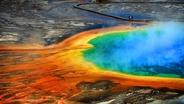(bright music) - [Eric] That water coming out of Grand Prismatic is somewhere around 89 degrees centigrade.
It's hard to imagine that life doesn't just exist in these hot springs; it thrives in these hot springs.
It's adapted specifically to these conditions in these hot springs.
If we can understand the kind of conditions that support microbiology and its origins on Earth, that will help narrow our search for life on other planets.
- [Narrator] The Grand Prismatic Spring is the most recognizable thermal feature of Yellowstone National Park.
While many of its mesmerizing qualities are easy to see, some of its most fascinating features are invisible to the naked eye.
Below the bubbling surface exists a diverse system of microbes, which scientists have been studying for decades and have been the catalyst for life-changing scientific discoveries, including the basis of the PCR test.
Now scientists are asking an even bigger question.
Could these microbes be the key to discovering life on other planets?
(bright music continues) (bright music) (bright music) - So Yellowstone National Park was the first national park established in the United States.
What makes Yellowstone special is the concentration and diversity of hydrothermal features and geysers.
So there are more geysers in Yellowstone than the rest of the world combined.
- It's a volcano, but it's not a cone type or a shield type volcano.
It's underground.
It's a huge magma chamber, and it's the heat source.
- [Eric] Essentially, it's like Hawaii, hotspot volcanism, except for the fact that you've got this continental crust over the top of it.
- [Lee] The water source is just normal surface water, rain, snow, so forth.
- So you have this huge amount of water that's essentially cooling that magma chamber.
When it cools, that water rises to the surface and forms these hydrothermal systems.
(bright music continues) (bright music) So Grand Primatic Spring is the largest hot spring in all of Yellowstone.
A truly magnificent example of hot springs.
Typically what the geologists tell us is that you find hydrothermal areas at the edges of lava flows.
This hot water's coming up from depth.
It wants to take the path of least resistance, which is not in the middle of a lava flow that's crystallized, it's at the peripheries.
So these lava flows essentially squeeze these hydrothermal fluids into pathways of least resistance, which is the Lower Geyser Basin, which is the Midway Geyser Basin, where we find Grand Prismatic, and the Upper Geyser basin, which is where we find places like Old Faithful.
- It's about 300 feet in diameter.
It has a discharge of 560 gallons of hot water per minute, which is rather astonishing if you think about it.
At the point where the hot water wells up out of the ground, the water temperature's about 183 degrees.
In 1993, and again in 1995, I had the privilege of going out on Grand Prismatic Spring on a specially designed thermal boat.
It looks precarious in that picture, but I don't- - Yeah, it does.
- I don't remember it feeling precarious.
No need to worry about life preservers.
I guess one thought that I had, if the boat somehow did tip over or something went wrong, that the agony wouldn't last very long.
(bright music) - Grand Prismatic is one of the most colorful springs there is, period.
And what is it that causes that deep blue color?
The bedrock here in Yellowstone is really silica-rich.
So these fluids come out saturated in silica.
Now, the silica refracts sunlight, blue sunlight, and that's why you see it as blue.
And as that water fans out towards the margins of that spring, it's cooling off.
And then all of a sudden you see this transition in color to orange, to yellow, to green.
And essentially what you're looking at there is a transition between different microbial groups, all photosynthetic, that make different pigments to harvest sunlight.
- There were many thermal researchers along the way, but the one that really springs to my mind is Dr. Thomas Brock.
And in or about 1966, he is the person who really got into studying what he called thermophilic microorganisms and life at high temperatures.
- NASA funds my research in particular because of their interest in understanding life's origins.
All of the life that you can see with your naked eye is ultimately supported by the sun.
This life is very different.
These organisms live off chemical energy, and it wasn't until about 2.8 billion years ago before life figured out how to harvest energy from the sun.
So for the first billion years of life's history on Earth, it was dependent on chemical energy.
Well, hydrothermal systems are unique in the fact that they bring that chemical energy to the surface.
(bright music) NASA's very interested in studying extremophiles because if you understood the environment that led to the emergence of life on Earth, and you could say, "Well, if everything else is the same on another planet, I should expect to find life there too."
And so if we understand how life originated on Earth, we can use that to also narrow our search for life on another planet.
One of the most phenomenal discoveries was a microorganism called Thermus aquaticus.
Thermus aquaticus was isolated by Tom Brock back in the 1960s, and after he isolated this organism, other researchers purified an enzyme out of this organism called Taq polymerase.
That's the basis of PCR.
We just made our way through the COVID pandemic.
If you had a rapid PCR test, the basis of that test has its roots in the hot springs of Yellowstone.
- [Jeff] I like the fact that the geothermals are independent of human beings.
One way I like to think about that is how the geothermals were doing what they do long before any people, even before the Paleo-Indians showed up here, certainly long before European Americans showed up here.
I often think of a quote from Aldo Leopold that there are some who can live without wild things and some who cannot.
For me, there's nothing like that feeling of wildness, which, fortunately, in Yellowstone, you can enter just a few hundred yards from the road.
- [Eric] We're still just at the tip of the iceberg in understanding what that biodiversity is and what it means.
It means that we need to do everything that we possibly can to preserve this wonderful place for generations to come.
(bright music)















